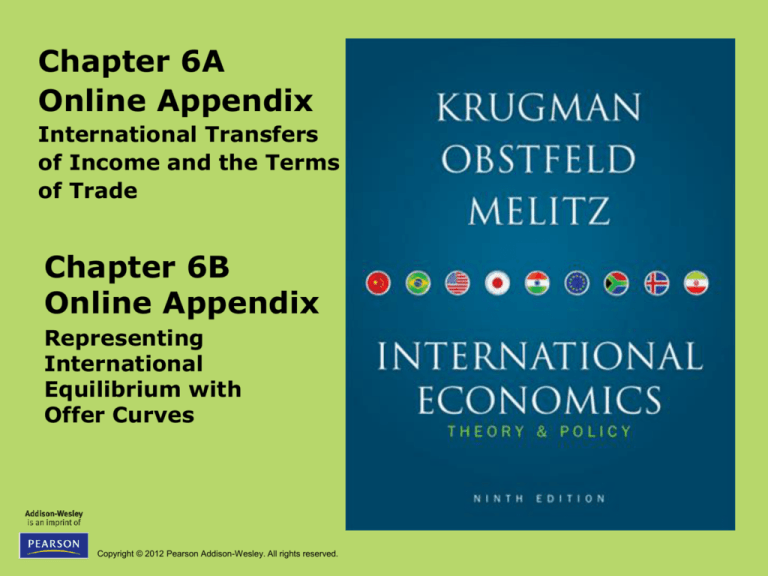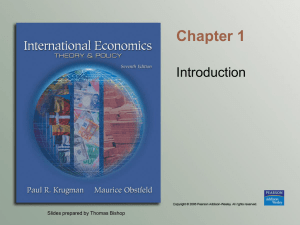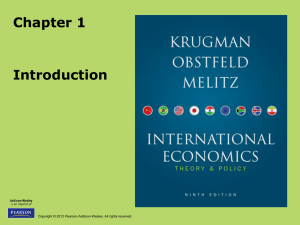
Chapter 6A
Online Appendix
International Transfers
of Income and the Terms
of Trade
Chapter 6B
Online Appendix
Representing
International
Equilibrium with
Offer Curves
Copyright © 2012 Pearson Addison-Wesley. All rights reserved.
Preview
• International Transfers of Income and the
Terms of Trade (Online Appendix A)
• Representing International Equilibrium
with Offer Curves (Online Appendix B)
Copyright © 2012 Pearson Addison-Wesley. All rights reserved.
6-2
International Transfers of Income and
the Terms of Trade
• Transfers of income sometimes occur from one
country to another.
– War reparations or foreign aid may influence demand for
traded goods and therefore relative demand.
– International loans may also influence relative demand in
the short run, before the loan is paid back.
• How do transfers of income across countries affect
relative demand and the terms of trade?
Copyright © 2012 Pearson Addison-Wesley. All rights reserved.
6-3
International Transfers of Income and
the Terms of Trade (cont.)
– If the domestic country generates national income for
transfers by
• increasing the price of imports to reduce their purchases
and
• by decreasing the price of exports to increase their sales,
– then the terms of trade would fall and the demand for
cloth relative to food would decrease (represented by
shifting the relative demand curve left).
Copyright © 2012 Pearson Addison-Wesley. All rights reserved.
6-4
Fig. 6A-1: Effects of a Transfer on
the Terms of Trade
Copyright © 2012 Pearson Addison-Wesley. All rights reserved.
6-5
International Transfers of Income and
the Terms of Trade (cont.)
• But after the transfer of income from the
domestic country,
– demand for foreign goods could fall in the domestic
country and demand for domestic goods could rise in the
foreign country,
– so the relative demand might not decrease and the
terms of trade might not fall.
Copyright © 2012 Pearson Addison-Wesley. All rights reserved.
6-6
International Transfers of Income and
the Terms of Trade (cont.)
• How much does demand for domestic goods
increase in the foreign country when it receives a
transfer of income from the domestic country?
– If the foreign country has a higher marginal propensity
to spend on its own goods rather than on imports,
demand for its own goods will rise more than demand
for imports from the domestic country.
Copyright © 2012 Pearson Addison-Wesley. All rights reserved.
6-7
International Transfers of Income and
the Terms of Trade (cont.)
• How much does demand for foreign goods
decrease in the domestic country when it reduces
its income through a transfer?
– If the domestic country has a higher marginal propensity
to spend on its own goods than on imports, demand for
its own goods will fall more than demand for imports
from the foreign country.
• If each country has a higher marginal propensity
to spend on its own products, relative demand
would decrease after a transfer of income from
the domestic country.
Copyright © 2012 Pearson Addison-Wesley. All rights reserved.
6-8
International Transfers of Income and
the Terms of Trade (cont.)
• In fact, countries spend most of their (marginal)
income on their own products.
– Americans spend only 11% of national income on
imports and 89% on domestically produced goods.
• Transportation costs, tariffs, other barriers, and
preferences cause domestic residents to favor
domestic goods.
• We predict that the relative demand will decrease
with a transfer of income, decreasing the terms of
trade for the donor nation.
Copyright © 2012 Pearson Addison-Wesley. All rights reserved.
6-9
International Transfers of Income and
the Terms of Trade (cont.)
• In addition, production of nontraded goods and
services may change, affecting the relative supply
of traded goods and reinforcing the change in the
terms of trade.
– Industries that produce non-traded goods and services
compete for resources with industries that produce
traded goods.
– A transfer of income from a donor country will reduce
demand and production of non-traded goods in the donor
country, so that these resources can be used in its export
sector.
Copyright © 2012 Pearson Addison-Wesley. All rights reserved.
6-10
International Transfers of Income and
the Terms of Trade (cont.)
– The supply of exports relative to imports in the
donor country increases, reducing the terms of
trade for the donor country.
– A transfer of income from a donor country will
increase demand for and production of nontraded goods in the foreign country, so that
fewer resources can be used in its export
sector.
– The supply of exports relative to imports in the
foreign country decreases, reducing the terms
of trade for the donor country.
Copyright © 2012 Pearson Addison-Wesley. All rights reserved.
6-11
Representing International Equilibrium
with Offer Curves
• On the horizontal axis Figure 6B-1 shows Home’s
exports of cloth, on the vertical axis Home’s
imports of food.
• The slope of the line from the origin of Figure
6B-1 to T is equal to PC / PF.
• At that price, Home residents are willing to trade
QC – DC units of cloth for DF – QF units of food.
• Calculating Home’s offer at different relative
prices traces out Home’s offer curve (Figure 6B2).
Copyright © 2012 Pearson Addison-Wesley. All rights reserved.
6-12
Fig. 6B-1: Home’s Desired Trade at a
Given Relative Price
Copyright © 2012 Pearson Addison-Wesley. All rights reserved.
6-13
Fig. 6B-2: Home’s Offer Curve
Copyright © 2012 Pearson Addison-Wesley. All rights reserved.
6-14
Representing International Equilibrium
with Offer Curves (cont.)
• Foreign’s offer curve (Figure 6B-3) is traced out in
the same way.
• On the vertical axis Figure 6B-3 shows Foreign’s
desired exports of food QF* – DF*, while the
horizontal axis shows Foreign’s desired imports of
cloth DC* – QC*.
• The lower the relative price of cloth PC / PF, the
more food Foreign will want to export and the
more cloth Foreign will want to import.
Copyright © 2012 Pearson Addison-Wesley. All rights reserved.
6-15
Fig. 6B-3: Foreign’s Offer Curve
Copyright © 2012 Pearson Addison-Wesley. All rights reserved.
6-16
Representing International Equilibrium
with Offer Curves (cont.)
• In international equilibrium:
– Home’s exports of cloth must match Foreign’s
imports of cloth
QC – DC = DC* – QC*
– and Foreign’s exports of food must equal
Home’s imports of food
QF* – DF* = DF – QF
Copyright © 2012 Pearson Addison-Wesley. All rights reserved.
6-17
Representing International Equilibrium
with Offer Curves (cont.)
• This is equivalent to requiring that the
world supply of cloth equal the world
demand for cloth and likewise for food:
QC + QC* = DC + DC*
QF + QF* = DF + DF*
• When you plot the Home and Foreign offer
curves on the same diagram (Figure 6B4), equilibrium occurs at the point where
the Home and Foreign offer curves cross.
Copyright © 2012 Pearson Addison-Wesley. All rights reserved.
6-18
Representing International Equilibrium
with Offer Curves (cont.)
• At the equilibrium point E, the relative
price of cloth is equal to the slope of OE.
• Home’s exports of cloth, which equal
Foreign’s imports, are OX. Foreign’s
exports of food, which equal Home’s
imports, are OY.
• This is a general equilibrium, in which
supply and demand are equalized in both
markets at the same time.
Copyright © 2012 Pearson Addison-Wesley. All rights reserved.
6-19
Fig. 6B-4: Offer Curve Equilibrium
Copyright © 2012 Pearson Addison-Wesley. All rights reserved.
6-20
Summary
1.
The effect of international transfers of income
depend on the marginal propensity to spend on
domestic goods.
•
2.
Generally such transfers cause a decrease in the
donor’s terms of trade due to decreasing the relative
demand for the donor’s exports.
Offer curves show what level of exports a
country is willing to trade for each level of
imports from another country, and they provide
another way to depict equilibrium.
Copyright © 2012 Pearson Addison-Wesley. All rights reserved.
6-21






